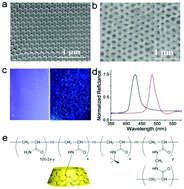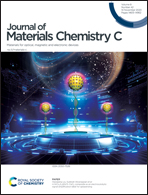A supramolecular photonic crystal hydrogel based on host–guest interactions for organic molecule recognition†
Abstract
The host component β-cyclodextrin (β-CD) and the guest component tertiary-butyl (t-Bu) were introduced into the polymeric backbone material of an inverse opal hydrogel. The association between β-CD and t-Bu functions as an openable cross-linker (“lock”) in the hydrogel. Meeting a competitive guest as the target molecule, 1-adamantanecarboxylic acid sodium (AdCANa) salt acts as a “key” to dissociate the pair of β-CD and t-Bu due to its stronger combination capacity with β-CD than t-Bu. At the same time, another cross-linker, N,N-methylenebisacrylamide (MBAAm), provides covalent bonds to the backbone material, ensuring that the subsequent association/dissociation of the host–guest pair only results in an expansion–contraction in volume, rather than a sol–gel phase transition. In this way, the target molecule acting as a competitive guest can cause an expansion-induced structural color change of the inverse opal hydrogel. Following the same strategy, the L- and D-enantiomers of tryptophan (Try) can also be recognized. The combination between the supramolecular host–guest pair and photonic crystals promises applicability in molecular recognition and other interesting optical devices.



 Please wait while we load your content...
Please wait while we load your content...